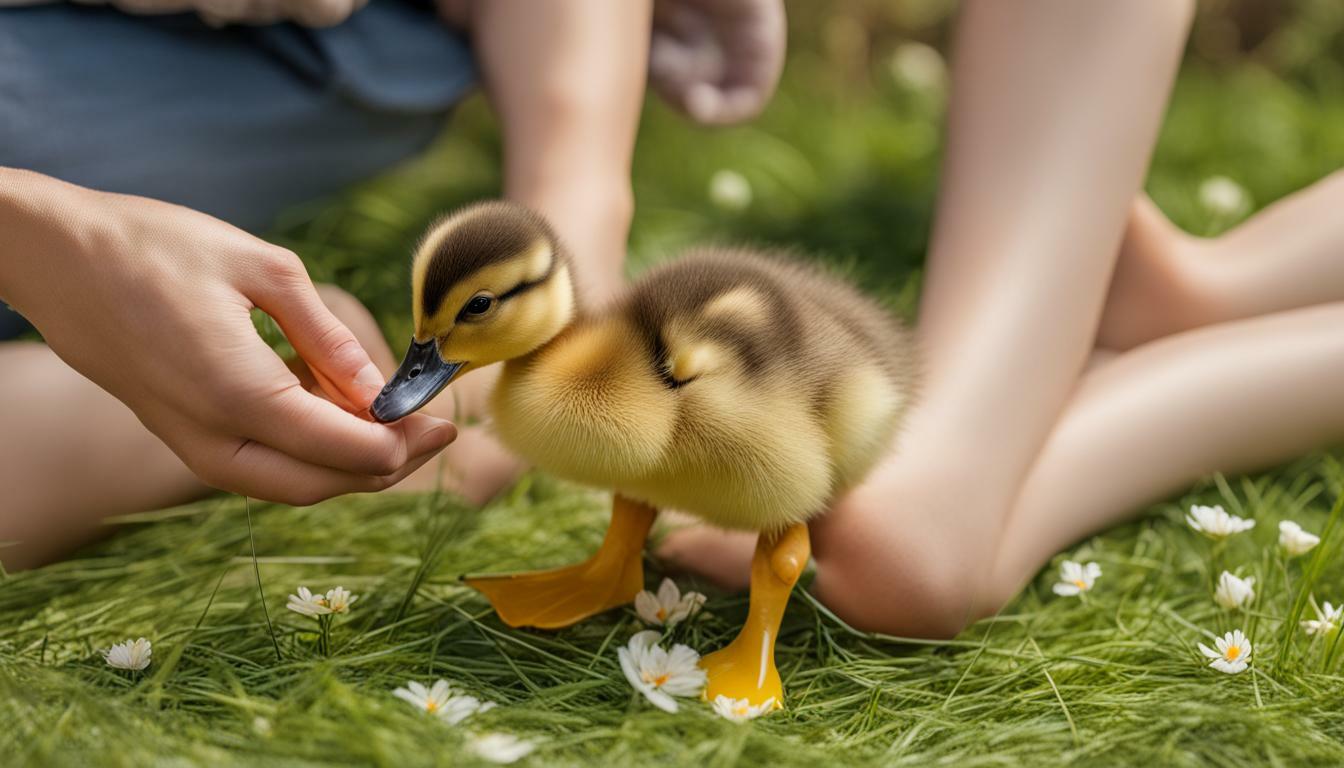How To Splint A Duck Leg? Easy And Safe Methods

Table of content:
Ducks are unfortunately prone to leg injuries that may require splinting their leg to aid in recovery. A broken or sprained leg can be very painful and debilitating for a duck, making it difficult for them to walk, swim, and forage. Immobilizing the injured leg can help prevent further damage and support proper healing.
If you have a domestic duck or come across an injured wild duck with a visibly broken, swollen, or lame leg that needs help, splinting the leg may be necessary. With some basic first aid knowledge and common household items, you can learn how to properly splint a duck’s leg at home before taking it to a veterinarian.
Why Splinting is Important for Duck Leg Injuries
Splinting an injured duck leg serves several important purposes:
- Immobilizes the injury – Stabilizing the leg prevents excess movement that could cause more pain, damage, and improper healing.
- Supports and protects the injury – The rigid splint helps keep the leg in proper alignment to heal. This also protects the soft tissues from further harm.
- Restores function – Once healed, a properly splinted leg has a better chance of regaining strength and mobility compared to an unsplinted break.
- Relieves pain – Limiting motion reduces pain and discomfort in the muscles and nerves surrounding the injury site.
- Aids recovery – Overall, splinting facilitates faster and more effective healing of leg fractures, sprains, strains, and other orthopedic conditions.
Without splinting, an untreated leg injury may heal improperly, limit mobility long-term, or fail to heal altogether. So it’s worth learning proper duck leg splinting techniques before an accident happens.
Signs Your Duck’s Leg Needs Splinting
How can you tell if your duck’s leg injury requires stabilization with a splint? Here are some of the most common signs:
- Visible swelling or bruising – Fluid buildup and bluish discoloration signal internal damage.
- Limping or inability to bear weight – Reluctance or inability to walk on the leg points to an injury.
- Joint sitting at an odd angle – The leg may bend abnormally if bones are fractured.
- Excess wobbliness – Too much instability or flopping in the leg area can mean serious injury.
- Pain reaction – Your duck vocalizing, biting, or avoiding contact suggests the leg is causing pain.
- Warmth and redness – Inflammation around the joint from strain or sprain.
- Crepitus – A crunching or crackling sound when handling the leg may indicate broken bones.
If you notice one or more of these signs in your duck’s leg, it’s best to gently immobilize it with a handmade splint and schedule a vet visit. Don’t try to straighten severely angled legs yourself – leave that to the professionals.
Supplies Needed for Duck Leg Splint
Splinting a duck’s leg doesn’t require expensive medical supplies – many household items can do the job in a pinch! Here are some recommended materials:
- Padding – Gauze, soft cloth, cotton balls, tissues, or paper towels
- Rigid supports – Craft sticks, popsicle sticks, tongue depressors, ice cream sticks, thick cardboard, wooden spoons
- Wrapping materials – Self-adhesive bandage, athletic tape, masking tape, duct tape, elastic bandage
- Scissors – For cutting tape or cloth strips
- Optional: Aluminum foil – Can mold as a splint shape if needed
The key is finding items that comfortably immobilize the leg without causing more harm. Avoid wire, plastic, or hard materials that could dig into the skin. Stay away from constricting ties that cut off circulation.
How to Make a Splint for a Duck
Follow these steps to properly construct a homemade splint for an injured duck leg:
1. Clean The Area
Gently wash your hands and clean the duck’s leg with mild soap and water. Be extremely careful handling the injury site. Dry the area thoroughly before splinting.
2. Apply Padding
Wrap a soft cloth or gauze around the leg area that will be in contact with the rigid splint pieces. Focus extra padding over any wounds or swollen spots. Padding prevents splint pressure and friction that could further damage tissue.
3. Position The Leg
Carefully guide the leg into a natural, relaxed posture without forcing mobility. Severe fractures should remain as-is for a vet to manipulate. Minor alignment adjustments are OK if the leg can be moved without pain. Proper leg position promotes better healing.
4. Affix Splint Pieces
Apply rigid supports like thick cardboard, craft sticks, wooden spoons, or stacked tongue depressors on each side of the padded leg. Place one longer piece under the leg, centered on the injury site. Use several shorter pieces above and below for optimal stabilization. Mold aluminum foil around the leg if you need a custom splint shape.
5. Wrap The Splint Securely
Use self-adhesive bandage, athletic tape, or masking tape to firmly bind the splint pieces around the leg. The wrap should fully immobilize the injury while allowing normal blood circulation. Leave a bit of padding exposed to monitor swelling. Check that wrapping isn’t too tight – a finger should slide underneath.
6. Check Comfort and Stability
Once the splint is in place, ensure your duck can stand and walk without too much difficulty. Make adjustments if needed until the leg is properly supported. Monitor that circulation isn’t impaired long-term. Add more rigid pieces if the splint isn’t immobilizing the injury adequately.
And that’s it – you’ve successfully splinted your duck’s injured leg! Keep a close eye on your duck’s condition and get them to an avian vet as soon as possible. Now let’s go over some other important splinting tips and FAQs.
Tips for Proper Duck Leg Splinting
Here are some additional pointers for safely and effectively splinting an injured duck leg:
- Only splint definite or suspected breaks, sprains, strains – not just limping.
- Monitor swelling under bandages – loosen if circulation is compromised.
- Check comfort levels – adjust if duck seems in pain from splint.
- Avoid getting bandages wet – rewrap if Duck goes swimming.
- Keep first aid supplies on hand before an emergency.
- Handle the leg gently – don’t try to “set” bones yourself.
- Immobilize joint above and below injury site for stability.
- Pad bony areas like joints to prevent skin sores from rigid splints.
- Watch out for the grabbing and Skin pinching when wrapping.
- Let a vet handle severe compound fractures – don’t splint those.
- Seek professional assistance ASAP – homemade splints are temporary.
Proper preparation, padding, and snug (not tight!) wrapping are key for an effective, humane splint that aids healing until your duck can receive veterinary care.
FAQs About Splinting Duck Legs
Here are answers to some common questions about immobilizing duck legs with homemade splints:
How long can a splint stay on a duck’s leg?
- Splints should be considered temporary and used for just 1-2 days before professional veterinary treatment. Monitor closely for any complications.
What signs mean the splint needs removing?
- Indications for splint removal include impaired circulation, greatly increased swelling, skin injury from the splint, or excessive difficulty standing/walking.
Can I just use duct tape instead of bandages?
- Duct tape alone directly on the skin can lead to tissue damage when removed. Use padding underneath and wrap gently.
Should I give my duck any medication for pain?
- Never give your duck drugs without your vet’s guidance. Some human meds like aspirin can be toxic. Let your vet prescribe duck-safe pain relief if needed.
Is it better to splint the leg straight or bent?
- For simple fractures, a natural standing/walking leg posture is best. Severe breaks should stay positioned as-is until X-rays determine proper placement.
Can a duck go swimming with a splinted leg?
- Avoid getting bandages wet – they should be changed after. Light swimming may be possible after vet approval if wrap stays dry.
How can I prevent my duck from injuring its leg again after splinting?
- Restrict activity, block off hard surfaces, fit leg braces, and monitor closely. Your vet can advise long-term remedies to prevent re-injury.
When should I take my duck to the vet after splinting its leg?
- Seek professional veterinary assistance as soon as possible – homemade splints are not a permanent fix. Urgent if circulation is compromised.
Final Thoughts
Splinting an injured duck leg correctly takes some first aid knowledge, improvised materials, and gentle handling. Avoid causing additional harm to damaged bones, muscles, and skin when immobilizing the area. Closely monitor your duck’s comfort level and healing progress after applying a homemade splint. This is only a temporary solution until a veterinarian can provide appropriate medical treatment, pain management, and advice for long-term care. With some preparation and practice, an effective duck leg splint can provide vital support and relief to your feathered friend in need. Just remember – always involve your trusted avian vet ASAP when dealing with serious duck injuries requiring splints or braces.
Welcome. I’m Adreena Shanum, the proud owner of this website, and I am incredibly passionate about animals, especially poultry. I founded adreenapets.com as a labor of love, stemming from my desire to share my knowledge and experiences with poultry enthusiasts worldwide.




